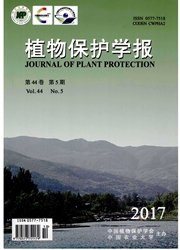

 中文摘要:
中文摘要:
喜旱莲子草是水陆两栖的入侵杂草,为探讨在利用其专食性天敌莲草直胸跳甲防治过程中,发现的陆生型喜旱莲子草控制效果不佳的原因,本试验从水分变化的角度,通过设置不同质量分数的聚乙二醇6000(PEG6000)(5%、10%、15%、20%和25%)模拟干旱环境,对喜旱莲子草胁迫处理后,饲喂莲草直胸跳甲幼虫和成虫,记录该跳甲取食后的发育历期、虫重、幼虫死亡情况、化蛹量及羽化量,结果表明:随着水分胁迫程度的加剧,莲草直胸跳甲1~3龄幼虫的发育历期延长,当胁迫质量分数达到25%时,各龄幼虫的发育历期均达到最长;而成虫的寿命随着水分胁迫程度增加而缩短,当胁迫程度为25%时,和对照相比寿命缩短了5.59d;不同虫态的鲜重随着胁迫质量分数的增加均有所下降,其中2龄幼虫和成虫的体重在25%时下降最显著,分别下降了3.19和2.34mg;1龄、2龄和3龄幼虫的死亡率均在胁迫质量分数为25%时达到最大,分别为对照的10.0倍、6.0倍和4.7倍;化蛹率和羽化率随着胁迫程度的加剧均降低,25%时化蛹率和羽化率最低,与对照相比分别降低了33.0%和37.5%。因此,干旱胁迫喜旱莲子草不利于莲草直胸跳甲的生长发育。
 英文摘要:
英文摘要:
Altemanthera philoxeroides is an amphibious invasive weed. Its natural enemy Agasicles hygrophila has been used as a bioontrol agent for the management of A. philoxeroides. However, the bio-control strategy was ineffecive. In order to investigate the reasons, five different PEG-6000 mass fraction gradients (5%, 10%, 15% ,20% and 25% ) were adapt to simulate to water stress conditions on A. philoxeroides,and the stressed plant grasses were used to feed A. hygrophila. Development duration,weight, motality,pupation rate and eclosion rate of flea beetle were recorded. The results showed that with the intensifying of water stress degree, 1 - 3 instar larvae stages of A. hygrophila were respectively extended; Under the stress mass fraction of 25%, development duration reached maximum;Adult longevity in experimental group became shorter with the water stress degree intensifying;Comparing with the control group,adult longevity is shortened by 5.59 d in the stress mass fraction of 25% ;The weights of flea beetle of the different stage were decreased,and the weights of the second instars and adults in 25% significantly fall by 3.19 mg and 2.34 mg, respectively; Larval mortalities of 1 - 3 instar larvae all were maximum in 25% and in this mass fraction each larval mortality was increased by 10.0,6.0 and 4.7 times, respectively ; Pupation rate and eclosion rate are increased respectively with the stress mass fraction increased;Pupation rate and eclosion rate was reduced by 33.0% and 37.5% respectively compared with the control group in 25%. In conclusion, A. philoxeroides under water stress effects the growth and development of A. hygrophila.
 同期刊论文项目
同期刊论文项目
 同项目期刊论文
同项目期刊论文
 期刊信息
期刊信息
